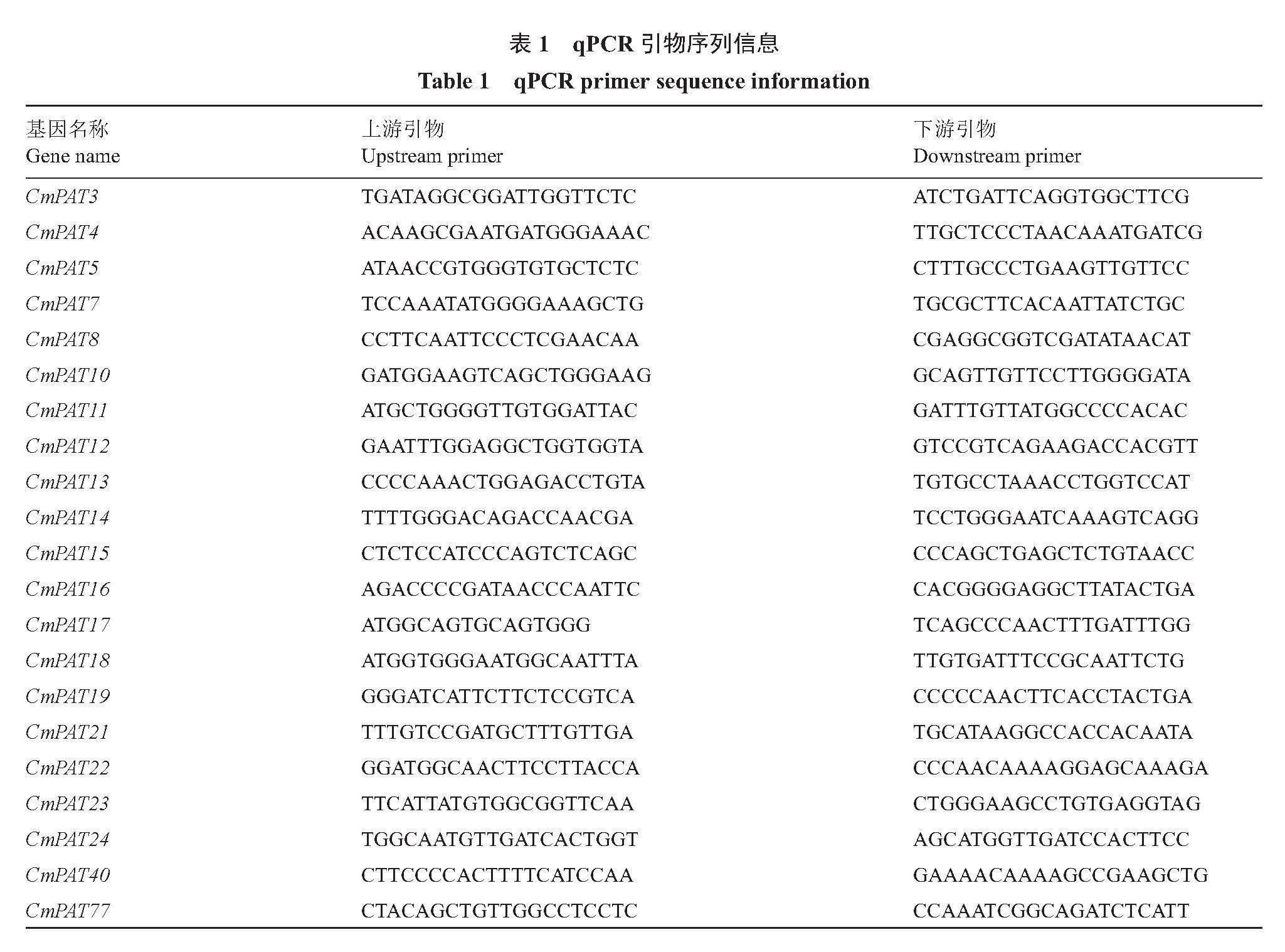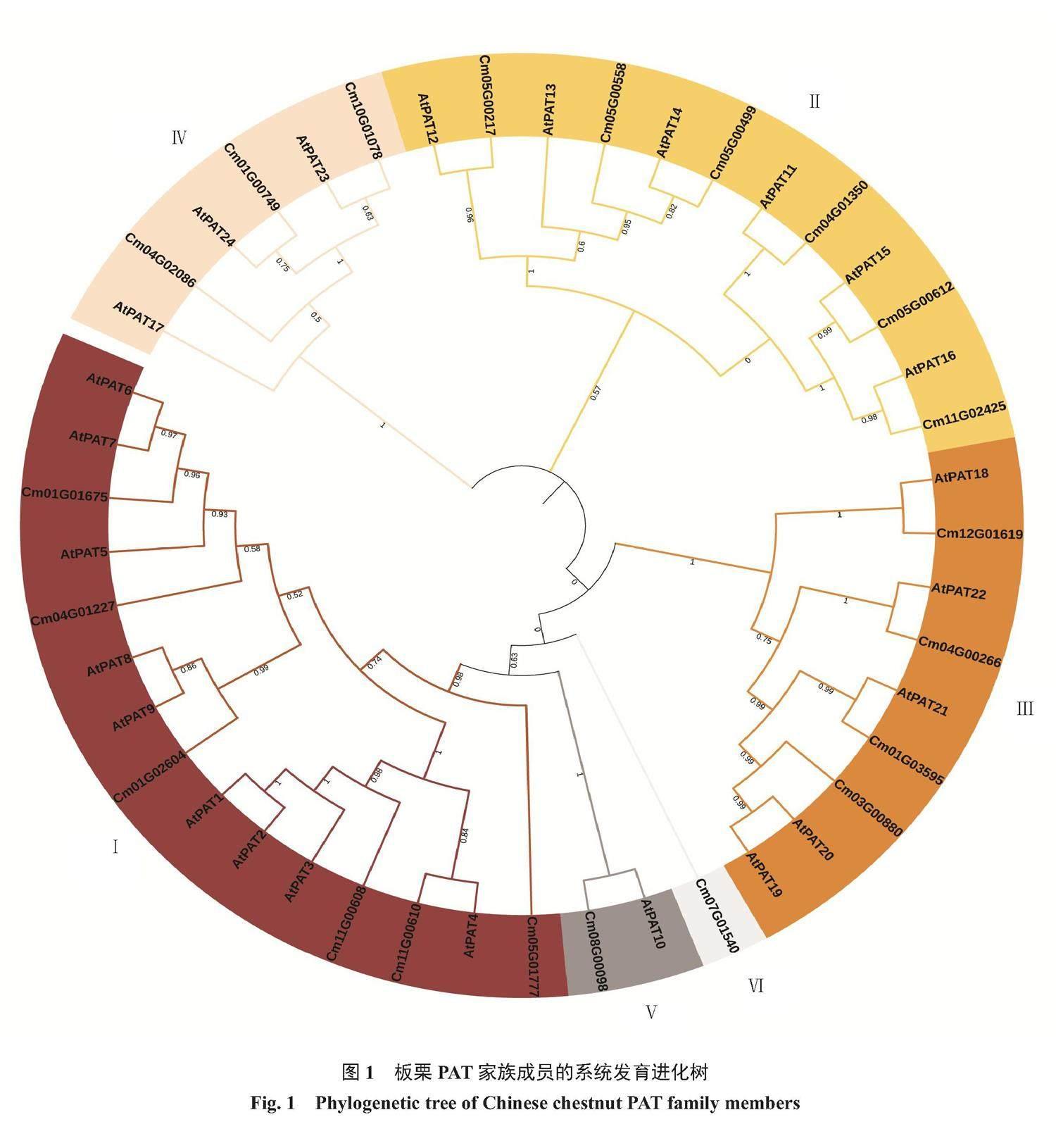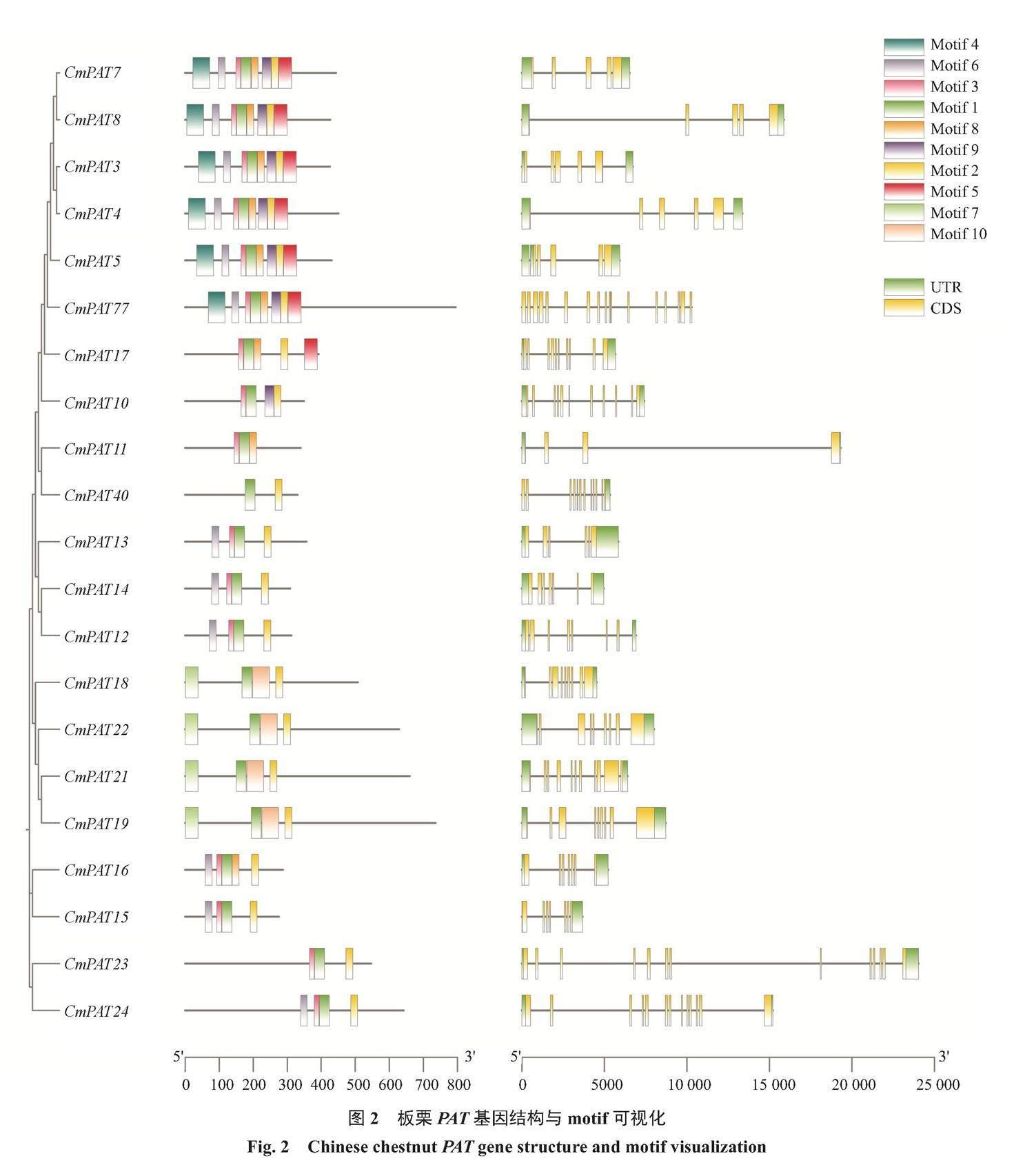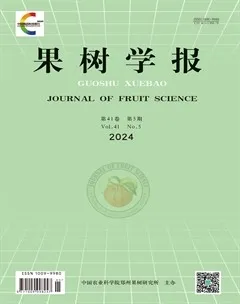板栗PAT基因家族成员鉴定及不同胁迫响应分析
李金梅 聂兴华 葛婧怡 褚世慧 刘阳 秦岭 邢宇



DOI:10.13925/j.cnki.gsxb.20230520
摘 要:【目的】鉴定和分析板栗PAT基因家族及其对不同胁迫的响应,探究板栗PAT基因家族的抗逆功能。【方法】在板栗全基因组水平上进行搜索和鉴定板栗PAT基因家族成员,利用生物信息学方法研究其系统发育进化树、基因结构和motif、蛋白理化性质、染色体定位、共线性和启动子顺式元件等。以燕山红栗为试验材料,分析盐胁迫、抗病胁迫和干旱胁迫处理对板栗PAT基因家族表达模式的影响。【结果】在板栗基因组中共鉴定出包含DHHC结构域的21个PAT基因家族成员,他们与24个AtPAT基因家族成员共聚集为6个亚组;大多数CmPAT家族成员为具有亲水性的碱性稳定蛋白;21个PAT基因家族成员不均匀地分布在板栗的9条染色体上;在CmPAT基因启动子区域鉴定到多种非生物胁迫及激素响应元件;表达模式分析表明,多个CmPAT基因不同程度地参与抗病、干旱、盐胁迫响应。【结论】共鉴定了21个板栗PAT基因家族成员,同时筛选到CmPAT24、CmPAT7、CmPAT14可能共同参与了盐胁迫和干旱胁迫的调控,CmPAT7可能共同参与盐胁迫、干旱胁迫、抗病胁迫的调控。
关键词:板栗;棕榈酰基转移酶(PAT);胁迫处理
中图分类号:S664.2 文献标志码:A 文章编号:1009-9980(2024)05-0847-14
收稿日期:2023-12-13 接受日期:2024-02-16
基金项目:国家自然科学基金项目(32271929)
作者简介:李金梅,女,在读硕士研究生,研究方向为果树分子生物学。E-mail:vmz0411@163.com
*通信作者 Author for correspondence. E-mail:xingyu@bua.edu.cn
果 树 学 报 2024,41(5): 847-860
Journal of Fruit Science
Identification of PAT gene family members and analysis of their response to different stresses in Chinese chestnut
LI Jinmei, NIE Xinghua, GE Jingyi, CHU Shihui, LIU Yang, QIN Ling, XING Yu*
(College of Plant Science and Technology, Beijing University of Agriculture, Beijing 102206, China)
Abstract: 【Objective】 The reversibility of protein palmitoylation is a key mechanism for regulating cellular function. Palmitoyl transferase is an important part of this mechanism, which can connect palmitic acid to the cysteine residue of the target protein. Protein palmitoylation is a post-transcriptional modification that plays a critical role in protein transport and function. Palmitate transferase (PAT) catalyzes the occurrence of acylation. Acylated PAT proteins may be involved in a variety of stress responses in material transport and signal transduction. Palmitate transferase plays an important role in growth, development and response to harmful stresses in plants. However, understanding of PAT genes in chestnut is limited so far. In the experiment, we performed a genome-wide identification of the PAT gene family in chestnut and subsequently analyzed how it responded to various stresses in Chinese chestnut. 【Methods】 HMMER, NCBI-CDD and SMART searches were performed to identify PAT genes throughout the chestnut genome. The domain information of the candidate gene family members was obtained through preliminary screening, and the protein sequences without the DHHC domain were eliminated. Ultimately, 21 members of the chestnut PAT gene family were identified. The bioinformatics methods were used to study the phylogenetic tree, gene structure and gene motif, protein physicochemical properties, subcellular and chromosomal localization, collinearity and promoter cis-elements of the PAT genes. To check the stress-resistant function of PAT gene family, Yanshanhong cultivar was used as experimental material. For salt treatment, the seedling roots were submerged in a solution containing 200 mmol·L-1 NaCl and samples were collected on the 7th, 10th and 14th days. Drought treatment was also carried out. Samples were collected and tested at different water loss in fresh leaves, specifically at 0%, 5%, 30% and 50%. To treat disease resistance, Chestnut Blight Mycelia Blocks were cultured on PAD medium. After 3 days, the PAD agar blocks containing chestnut blight mycelia were placed on perforated branches. Samples were collected at 0 h, 12 h, 24 h and 3 days after inoculation. Fresh branches that were only treated with punching served as controls. All samples were then harvested, immediately frozen in liquid nitrogen, and stored at -80 ℃. The influence of salt, disease resistance and drought stress on the expression pattern of the PAT gene family was examined using the real-time quantitative fluorescence analysis. 【Results】 Through a comprehensive genome search and identification, we acquired 21 members of the PAT gene family in the chestnut genome that possessed the DHHC domain. In the phylogenetic evolutionary tree, they grouped into six branches with 24 members of the AtPAT gene family. By analyzing the physical and chemical properties of the protein, it was found that most members of the CmPAT family were hydrophilic, basic and stable proteins, and that their sequence lengths varied significantly. Subcellular localization showed that CmPAT7 was localized in the chloroplast, CmPAT4 in the nucleus, CmPAT23 in the cytoplasm, and the remaining PAT proteins in the plasma membrane. Gene structure and motif visualization showed 10 conserved motifs, and 21 PAT family members all had the DHHC domain, which was the most conserved. Their gene lengths also varied widely, ranging from 3750 to 24 300 bp, and each family member contained 7.28 introns and 8.57 exons. Members of the PAT gene family were unevenly distributed across the nine chromosomes. The CmPAT gene family was more conserved in the process of species differentiation. There were many abiotic stress and hormone response elements in the promoter region of the CmPATs gene. These included basic cis-acting elements, light-response elements, hormone-response elements and many stress-response elements, of which cis-acting and light response elements accounted for the largest proportion. An examination of the transcription factor prediction word cloud identified up to 39 transcription factors related to the control of 21 CmPATs gene. Of these, the Dof protein family was the most abundant at 22%, followed by the AP2/ERF protein family and the BBR-BPC protein family at 17% and 10%, respectively. These protein families may play a crucial role in regulating PAT genes in chestnut. Analysis of the expression pattern revealed that several CmPAT genes were involved to varying degrees in responses to disease resistance, and drought and salt stress. 【Conclusion】 A total of 21 CmPATs gene were identified. The study found that the expression levels of CmPAT24, CmPAT7 and CmPAT14 significantly increased in response to salt and drought stresses, demonstrating their involvement in the regulation of these stressors. Notably, the CmPAT7 gene showed significant upregulation under salt, drought and disease resistance stresses, indicating its role in regulating all three types of stresses.
Key words: Chinese chestnut; Palmitate transferase (PAT); Stress treatment
生物体正常行使功能必须依赖蛋白质等大分子物质,经复杂翻译修饰作用(post-translatioanal modification,PTM)的蛋白质可以发挥正常功能及相互之间的调节作用[1]。蛋白质翻译修饰的类型众多[2],其中,脂链修饰根据连接脂肪酸链的类型不同,分为豆蔻酰化(myristoylation)、酰基化(acylation)等类型[3-5]。棕榈酰基转移酶(palmitate transferase,PAT)催化的酰基化是将棕榈酰基以硫脂键的方式转移到蛋白质的半胱氨酸残基上,从而影响蛋白质生物合成过程[6-8]。催化这个反应的是一类活性中心含有Asp-His-His-Cys (DHHC)基序的酶,因此它们又被称为DHHC家族[9]。棕榈酰基转移酶最先被发现于酵母中[10-11],并广泛存在于哺乳动物与植物中[12-13]。在杨树的相关研究中,利用酰基-生物素交换法和质谱法鉴定出的酰基化蛋白参与物质运输、信号转导和胁迫的响应[14]。其中DHHC类棕榈酰基转移酶是目前研究最多的家族。前人研究表明,在许多高等植物基因组中均鉴定出了数目不等的PAT家族成员,例如水稻(Oryza sativa)有30个,玉米(Zea Mays)有40个,拟南芥(Arabidopsis thaliana)有24个等[15-16]。人们对拟南芥中PAT家族成员研究最为透彻,其中AtPAT4[17]、AtPAT10[18]、AtPAT13、AtPAT14[19-20]、AtPAT15[21]、AtPAT21[22]、AtPAT24[23]等在生长发育、衰老、非生物胁迫反应等过程中具有重要作用,并且根据演化关系将拟南芥中24个PATs聚为3个分支,PAT1~9属于分支一,PAT11~16属于分支二,PAT18~22属于分支三,其余成员由于演化关系较远并未进行聚类分析[24]。
板栗(Castanea mollissima)原产于我国,营养物质丰富,是中国重要的经济作物之一。中国的板栗种植总面积约为186.6万hm?,年产量高达194.7万t,占世界板栗年总产量一半以上,稳居世界首位[25]。板栗种植主要位于浅山地带,灌溉条件有限,往往靠自然降水补充水分。同时,当栽植地区的土壤pH超过7.5、含水量低于田间最大持水量的26.6%时,其生长阶段易受到多种环境胁迫的影响,包括盐胁迫、干旱胁迫等[26]。板栗生产中也会遭受多种病虫害侵袭,其中栗疫病最为严重[27]。因此,提高板栗的抗逆性,对提高板栗产业极为重要。
笔者通过比对PAT保守结构域序列,在板栗全基因组中鉴定出了21个PAT基因家族成员,并分析其系统发育树、基因结构、理化性质、染色体定位、共线性和启动子顺式作用元件等信息,同时分析板栗PAT家族在不同胁迫下的基因表达模式,为板栗PAT基因家族抗逆功能的分析提供理论研究基础。
1 材料和方法
1.1 试验材料
材料为在北京市怀柔区板栗试验站采集的燕山红栗,选取大小、质量一致的燕山红栗种子,放置在温度24 ℃、湿度60%的恒温培养箱中催芽,催芽后利用1/2 Hogland营养液进行水培,置于人工气候室(室温23~25 ℃,光周期:16 h光照/8 h黑暗)培养,获得具有根系的板栗实生苗,选取生长一致的幼苗进行后续试验。
1.2 板栗PAT基因家族成员的鉴定及多序列比对和系统进化树构建
从板栗基因组网站(http://castaneadb.net/)下载板栗基因组数据,包括基因数据文件,蛋白数据文件、GFF注释文件等。利用pfam(http://pfam.xfam.org/)查找PAT家族基因隐马尔科夫模型(PF01529),并下载所需家族hmm数据信息。使用HMMER3.0搜索得到24个PAT蛋白序列,利用NCBI(https://www.ncbi.nlm.nih.gov/Structure/cdd/wrpsb.cgi)Conserved Domain Search和SMART对初筛得到的候选基因家族成员进行结构域信息查对,对比剔除无DHHC结构域的蛋白序列,最终确定21个板栗PAT基因家族成员。将选取的21个板栗PAT蛋白序列和24个拟南芥PAT蛋白序列使用ClustalW进行多序列比对,通过软件MEGA11.0[28]中的最大似然法(maximum likelihood,ML)构建进化树,Bootstrap检验设定1000次重复,其他参数设置为默认参数。使用在线网站itol(https://itol.embl.de/)对系统发育进化树进行美化。并根据与拟南芥的进化关系,对板栗进行命名,例如Cm08G00098命名为CmPAT10、Cm05G00499命名为CmPAT14、Cm01G01675命名为CmPAT7、Cm04G01227命名为CmPAT5、Cm05G00558命名为CmPAT13、Cm01G02604命名为CmPAT8、Cm11G00608命名为CmPAT3、Cm03G00880命名为CmPAT19、Cm04G02086命名为CmPAT17等,进化关系较远或无进化关系的Cm07G01540命名为CmPAT40、Cm05G01777命名为CmPAT77。
1.3 板栗PAT基因结构与Motif可视化分析
利用MEME(http://meme-suite.org/tools/meme)进行CmPATs保守结构域分析,使用TBtools中的Gene Structure View对基因结构和保守结构域进行可视化分析。
1.4 板栗PAT基因家族的蛋白质理化性质分析和亚细胞定位
利用ExPASy(https://www.expasy.org/)对板栗PAT基因家族成员进行蛋白质理化性质分析,预测 PATs 氨基酸数目、蛋白分子质量、等电点、亲水性平均系数、脂肪系数等,通过WoLF PSORT(https://www.genscript.com/wolf-psort.html)预测PAT蛋白的亚细胞定位。
1.5 板栗PAT基因家族染色体定位与共线性分析
使用MCScanX(The Multiple Collinearity Scan toolkit)工具进行染色体定位分析并作可视化处理[29],并对板栗与拟南芥PAT基因的复制事件进行共线性分析[30],使用TBtools作可视化图。
1.6 板栗PAT基因家族的启动子顺式作用元件分析
在TBtools软件中,提取PAT基因上游的启动子前1.5 kb序列,顺式作用元件的预测利用PlantCARE(http://bioinformatics.psb.ugent.be/webtools/plantcar-e/)进行[31],可视化结果使用TBtools绘图显示。
1.7 板栗PAT基因转录因子的预测
CmPATs基因的转录因子由在线网站http://plantregmap.gao-lab.org/预测得到[32],其词云由在线网站https://www.genescloud.cn/制作而成。
1.8 不同的胁迫处理
选取生长状况一致的水培实生苗进行土培,对土培材料进行200 mmol·L-1 NaCl的胁迫处理,以不加NaCl为对照,每个处理3盆(1盆1株),并分别在7、10和14 d时采取同样位置0和200 mmol·L-1 NaCl处理的叶片。
在进行干旱处理时,选取长势一致的水培转土培的板栗实生苗30株,采摘新鲜叶片,分别在新鲜叶片失水量为0%、5%、30%和50%时取样。
在进行抗病处理时,选取新鲜板栗树枝条,用打孔器打孔,深度以达到形成层未到木质部为准,将培养3 d的栗疫病菌丝块接种于枝条的打孔处。以只进行打孔处理的新鲜枝条为对照。取样时间分别为接种后的0、12、24 h和3 d。
以上样品均用液氮进行速冻后放置-80 ℃超低温冰箱保存待测,每个处理均为3次重复。
1.9 RNA提取、cDNA合成及实时荧光定量PCR分析
使用E.Z.N.A. Plant RNA Kit(Omega)试剂盒提取RNA。cDNA的合成使用Reverse Transcriptase M-MLV(RNase H-)试剂盒(TaKaRa,大连)。选择Cmactin作为内参基因[20],利用Primer 3.0设计21个CmPAT基因的qPCR引物(表1),并由生工生物工程股份有限公司(上海)合成。使用Super Real Pre MixPlus (SYBR Green)试剂盒(Takala,大连),在CFX96(BIO-RAD,USA)上进行反应,每个样品3次重复。qPCR反应程序为:预变性95 ℃ 2 min,变性95 ℃ 15 s,退火58 ℃ 30 s,延伸72 ℃ 30 s,共40个循环。利用2-△△Ct法计算CmPATs相对表达量。
2 结果与分析
2.1 板栗PAT基因的系统进化树分析
利用HMMER、NCBI-CDD和SMART在板栗全基因组水平上进行搜索,并对获得的CmPAT基因进行Blast,最终鉴定了21个CmPAT基因。为了解CmPAT蛋白的功能及进化关系,将21个CmPAT蛋白序列与拟南芥的24个AtPAT蛋白进行蛋白多序列比对,构建系统发育进化树(图1)。根据拟南芥分组情况,将系统进化树分成6个亚组(Ⅰ~Ⅵ)。在6个亚组中,Ⅴ组和Ⅵ组为最小分支组,分别仅有一个成员:Cm08G0098和Cm07G01540,最大分支组为Ⅰ组(AtPAT1~9)和Ⅱ组(AtPAT11~16),均有6个成员。在多序列比对中,21个CmPAT成员均具有DHHC结构域。
2.2 CmPATs的基因结构和Motif可视化分析
为了深入研究CmPATs的结构异同,通过在线网站MEME,在系统发育树的基础上预测到了PAT序列中的10个保守基序和基因结构图(图2)。在21个PAT基因中,发现每个PAT基因中包含不同种类和数目的Motifs。其中Motif4存在于6个CmPAT基因中(CmPAT7、CmPAT3、CmPAT4、CmPAT5、CmPAT77、CmPAT8),Motif5存在7个CmPAT基因中(CmPAT7、CmPAT3、CmPAT4、CmPAT5、CmPAT77、CmPAT8、CmPAT17)、Motif7和Motif10共同存在4个CmPAT基因中(CmPAT22、CmPAT21、CmPAT18、CmPAT19),说明它们具有相似的功能,在进化关系上也比较近。各个CmPAT的基因长度差异较大,范围为3750~24 300 bp。所有的PAT基因都含有Motif1,则Motif1应为DHHC保守结构域。CmPAT77不存在UTR区,CmPAT40、CmPAT15只有1个UTR区,其他基因都具有2个以上的UTR区。
2.3 板栗PAT基因家族的蛋白理化性质分析和亚细胞定位
利用pfam数据库与板栗V4基因组进行比对分析,获得了板栗基因组中包含一个DHHC结构域的21个基因。随后对其蛋白序列进行蛋白质理化性质分析,发现序列长度差异较大,在274~794个氨基酸之间,氨基酸长度最长的是CmPAT77,最短的是CmPAT15。平均分子质量为51.27 kDa,等电点为5.91~9.82,其中只有CmPAT3、CmPAT14、CmPAT23、CmPAT24、CmPAT77这5个蛋白的PI小于7,说明多数板栗PAT蛋白表现为碱性,少数为酸性。脂肪指数为73.60~104.69。蛋白的平均亲水性(GRAVY)为-0.279~0.419,其中GRAVY为正值的有10个CmPAT蛋白,负值的有11个CmPAT蛋白。通过蛋白疏、亲水性分析发现,仅有CmPAT12、CmPAT13、CmPAT16、CmPAT17、CmPAT40、CmPAT77这6个PAT蛋白脂肪系数大于100,为疏水性蛋白,其余均为亲水性蛋白。同时,有12个PAT蛋白的不稳定系数小于40,9个PAT蛋白不稳定系数大于40,表明板栗PAT家族中大多为稳定蛋白。其中CmPAT77除了上述PAT家族共有的DHHC保守结构域外,还具有特异的泛素蛋白激酶序列。通过WoLF PSORT Prediction进行亚细胞定位,发现CmPAT7定位在叶绿体,CmPAT4定位在细胞核,CmPAT23定位在细胞质,剩余18个PAT蛋白定位在质膜中(表2)。
2.4 板栗PAT基因的染色体定位和共线性分析
绘制CmPAT基因在染色体上的分布图,并利用1~12号染色体表示基因在染色体上的分布(图3)。21个基因家族成员不均匀分布在1号、3号、4号、5号、7号、8号、10号、11号和12号染色体上,2号、6号和9号染色体上没有CmPAT基因的分布。CmPAT24、CmPAT7、CmPAT8、CmPAT21分布于1号染色体上,CmPAT19分布在3号染色体上,CmPAT17、CmPAT11、CmPAT5和CmPAT22分布在4号染色体上,CmPAT77、CmPAT15、CmPAT13、CmPAT14、CmPAT12分布于5号染色体上,CmPAT40、CmPAT10、CmPAT23分别分布在7号、8号和10号染色体上,CmPAT3、CmPAT4及CmPAT16分布在11号染色体上,CmPAT18分布在12号染色体上。对板栗和拟南芥PAT基因进行共线性分析发现,在板栗与拟南芥之间存在10个具有共线性关系的PATs,在板栗间无共线性关系的PATs。板栗和拟南芥的PAT数目相差不大,因此CmPAT基因家族在物种间分化过程中比较保守(图4)。
2.5 CmPATs基因启动子顺式作用元件分析
为探索CmPAT基因的功能,将21个板栗PAT基因上游1.5 kb的启动子序列提交到PlantCARE网站进行顺式作用元件预测。如图5所示,在板栗PAT基因的启动子区域中预测到基本顺式作用元件、光响应元件,激素响应元件,多种逆境胁迫响应元件,植物生长发育相关元件等。基本顺式作用元件数量最多,其中有943个TATA-box、623个CAAT-box 和152个AT~TATA-box等启动子元件;其次为光响应元件,包括42个Box4、24个G-box、16个TCT-motif、13个GATA-motif、11个MRE、9个GT 1-motif等;在植物激素响应元件中,含有45个生长素响应元件(ARE、TGA-element)、19个赤霉素响应元件(P-box、TATC-box、GARE-motif、F-box)、24个乙烯响应元件ERE、60个脱落酸响应元件(ABRE、AAGAA-motif、ABRE4、ABRE3a)、42个水杨酸响应元件(as-1、TCA、TCA-element)等;在逆境胁迫响应元件中,含有7个干旱诱导元件(MBS、MBSI)、12个低温响应元件LTR、20个损伤诱导元件(WUN-motif、WRE3)、12个抗病响应元件W-box等;植物生长发育相关元件包括12个参与玉米醇溶蛋白代谢调节元件O 2-site、4个与植物胚乳发育相关元件(GCN 4_motif、AACA_motif)、1个参与种子特异调控元件RY-element等;此外还预测到66个MYB和61个MYC参与环境适应性的响应元件等。推测CmPAT基因在板栗生长发育、激素调控、逆境胁迫及光调控中发挥着重要作用。
2.6 板栗PAT转录因子对应的词云分析
通过转录因子预测发现,与21个板栗PAT基因调控相关的转录因子多达39种,其中以Dof蛋白家族的数量最多,BBR-BPC、AP2/ERF、MYB蛋白家族的数量在300~400之间,C2H2、GRAS、NAC、WRKY、TCP、HD-ZIP蛋白家族的数量在100~250之间,bHLH、TALE、bZIP、Trihelix、MYB_related、LBD、CPP、GATA、G2-like、MIKC_MADS、B3、WOX、HSF、C3H、ARF、ZF-HD、SBP蛋白家族的数量在20~85之间。其中Dof占比22%,AP2/ERF占比17%,BBR-BPC占比10%。这些转录因子可能在板栗中PAT基因的转录过程中发挥着重要作用(图6)。
2.7 板栗PAT基因参与不同胁迫响应
为进一步了解板栗PAT基因在不同胁迫条件下的作用,对板栗实生苗进行不同浓度盐胁迫和干旱胁迫处理,进行板栗PAT基因表达量热图绘制。
如图7-A所示,21个CmPAT基因在不同时期不同程度地参与了盐胁迫响应。在7 d时,相对于对照,有2个基因表达上调,5个基因表达下调。在10 d时,有11个基因表达上调,其中有6个基因表达明显上调,2个基因表达明显下调。在14 d时,有6个基因表达上调,5个基因表达下调,其中4个基因表达明显下调。以上结果说明CmPAT基因广泛参与盐胁迫的响应。在干旱胁迫处理中,失水量为5%时,有2个基因表达明显上调,失水量为30%时,有7个基因表达明显上调,失水量为50%时,仅有1个基因表达未上调,且无表达下调的基因,说明CmPAT基因亦广泛参与干旱胁迫响应。CmPAT24、CmPAT7、CmPAT14共同正向参与响应盐胁迫与干旱胁迫(图7-B)。
在植物生长过程中,除了非生物胁迫以外,还面临着病原菌的侵染等生物胁迫,抗病的作用机制也较为复杂。在CmPAT基因响应抗栗疫病的转录组数据中发现,整体基因表达量数值较低。在栗疫病病菌侵染12 h时,与对照相比,基因表达量明显上调的有2个,为CmPAT11和CmPAT4,分别上调了1.11倍和1.39倍,仅有CmPAT17表达量明显下调,下调了72.61%。在栗疫病病菌侵染24 h时,与对照相比,有6个基因表达量明显上调,分别为CmPAT24、CmPAT7、CmPAT16、CmPAT17、CmPAT14、CmPAT77,其基因表达量上调在1.5倍以上,其中CmPAT14和CmPAT77的基因表达量分别上调了2.79倍和2.49倍;CmPAT21和CmPAT22基因表达量下调较为明显,分别下调了31%和37%。在栗疫病病菌侵染3 d时,与对照相比,有6个基因表达量明显上调,分别为CmPAT7、CmPAT10、CmPAT16、CmPAT23、CmPAT17、CmPAT4,其基因表达量上调在1.5倍以上,其中CmPAT7和CmPAT17表达量分别上调2.61倍和2.44倍;CmPAT21、CmPAT5、CmPAT77基因表达量下调较为显著,分别为42%、44%、57%。CmPAT7、CmPAT16和CmPAT17基因表达量在24 h和3 d 2个时期里均明显上调,CmPAT21和CmPAT77均明显下调,说明他们可能参与了响应栗疫病胁迫的网络(图7-C)。不同的CmPAT基因在不同胁迫中具有不同程度的响应,其中CmPAT7正向参与了盐胁迫、干旱胁迫和抗病胁迫的调控。
3 讨 论
蛋白质棕榈酰化是一种后转录修饰的可逆反应,棕榈酰基转移酶催化酰基化的发生,发生酰基化的蛋白可以参与多种物质运输、信号转导胁迫响应。因此PAT家族作为参与调控植物生长发育与逆境胁迫的相关蛋白逐渐进入人们的视野。
在本研究中,笔者共鉴定出板栗中21个PAT基因家族成员,其基因数目与拟南芥基因数目接近,但不同物种间的PAT基因家族成员数目差异说明该基因家族在植物进化过程中产生一定程度的分化和扩增[33]。将鉴定出的CmPAT家族成员通过系统发育进化树、基因结构和motif、蛋白质理化性质、染色体定位、基因复制事件、共线性和不同胁迫下表达模式等生物信息学方法进行综合分析。
在系统发育进化树中发现21个CmPAT蛋白中有17个与拟南芥成员存在同源关系,在同一个亚组中的成员含有一致或相似的蛋白保守基序,支持了进化分析的结果,同时也表明在氨基酸水平上存在同源关系的CmPAT和AtPAT间可能具有相似的生物学功能。Zhou等[18]对定位在液泡的AtPAT10的功能进行研究,表明AtPAT10对拟南芥的发育及耐盐性至关重要,因此CmPAT10可能也具有耐盐性等功能。通过分析板栗PAT基因上游启动子中顺式作用元件的组成情况发现,其上游存在大量生长发育和各种胁迫应答相关的顺式作用元件,他们在转录过程中可能受到多种转录因子的调控,以此提高板栗在生长发育过程中的抗逆性。这与其他物种通过对启动子进行分析来研究PAT家族成员对不同非生物胁迫等的响应机制结果一致[34-36]。
板栗在生长过程中,易受到盐害和干旱等非生物胁迫。张新业等[37]对鉴定的27个胡萝卜PAT基因进行盐胁迫处理,发现有3个DsPAT响应了盐胁迫。本研究中盐胁迫处理下发现CmPAT24、CmPAT7、CmPAT13、CmPAT14在10 d和14 d表达上调显著。笔者推测这些基因在不同时期可能参与板栗对盐胁迫的响应,与前人研究结果相似。Tian等[33]发现OsPAT30参与了水稻耐盐性的调控。Qi等[38]研究表明,拟南芥中的一个棕榈酰基转移酶AtPAT10对盐胁迫响应极为敏感。姜翰[39]在对苹果PAT16的功能进行研究时发现MdPAT16能抵抗盐胁迫并促进苹果糖分的积累。但在拟南芥和苹果中响应盐胁迫的PAT10和PAT16在板栗实生苗中并没有明显的响应,这与前人研究结果不一致,同时Tian等[33]的结果也表明了PAT基因功能在不同物种中对盐胁迫具有一定的保守性。此外,吕慧等[40]发现干辣椒果实在干旱和盐胁迫的共同刺激下,促进了10个基因的表达。在本研究中,CmPAT24、CmPAT7、CmPAT14亦共同正向响应盐胁迫和干旱胁迫,这与吕慧等[40]的研究结果一致,在盐胁迫和干旱胁迫双重胁迫下促进多个基因的表达。ZmPAT24(ZmTIP1)能够调节玉米根毛的长度及参与干旱胁迫的调控[41]。在本研究中,干旱胁迫失水量50%时,大部分CmPAT基因的表达量均上调,仅有CmPAT21未表现出明显的抗旱性。这与前人研究结果相似,不同之处在于大部分CmPAT基因均参与调控板栗响应干旱胁迫。据报道,Deng等[36]发现部分GhPAT基因在病原菌、干旱、盐等非生物胁迫下参与响应,并验证了GhPAT27参与陆地棉花黄萎病抗性响应。Gao等[42]发现AtPAT13和AtPAT16通过棕榈酰化修饰NB-LRR蛋白R5L1调控拟南芥的抗病机制。在本研究中,根据抗病胁迫转录组测序的结果发现,CmPAT7、CmPAT16和CmPAT17基因表达量在24 h和3 d 2个时期均明显上调,CmPAT21和CmPAT77均明显下调。说明他们可能参与了响应栗疫病胁迫的网络。推测这5个基因极有可能参与板栗抗栗疫病的响应,并在板栗抗栗疫病中特异表达。CmPAT24、CmPAT7、CmPAT14共同响应盐胁迫和干旱胁迫的调控,CmPAT7共同响应盐胁迫、干旱胁迫和抗病胁迫的调控,部分CmPAT基因共同参与各种胁迫,与前人的研究结果一致。
4 结 论
笔者在本研究中共鉴定出21个板栗PAT基因家族成员,他们在盐胁迫、干旱胁迫和抗病胁迫等生物和非生物胁迫中发挥着重要作用。其中CmPAT24、CmPAT7、CmPAT14共同正向参与了盐胁迫和干旱胁迫的调控,CmPAT7同时正向响应盐胁迫、干旱胁迫和抗病胁迫。研究结果可为研究板栗PAT基因家族的抗逆功能提供理论基础。
参考文献References:
[1] LI Y H,ZHANG Y Z,FENG F J,LIANG D,CHENG L L,MA F W,SHI S G. Overexpression of a Malus vacuolar Na+/H+ antiporter gene (MdNHX1) in apple rootstock M. 26 and its influence on salt tolerance[J]. Plant Cell,Tissue and Organ Culture,2010,102(3):337-345.
[2] MANN M,JENSEN O N. Proteomic analysis of post-translational modifications[J]. Nature Biotechnology,2003,21:255-261.
[3] WALSH G,JEFFERIS R. Post-translational modifications in the context of therapeutic proteins[J]. Nature Biotechnology,2006,24(10):1241-1252.
[4] SEET B T,DIKIC I,ZHOU M M,PAWSON T. Reading protein modifications with interaction domains[J]. Nature Reviews Molecular Cell Biology,2006,7:473-483.
[5] SOREK N,BLOCH D,YALOVSKY S. Protein lipid modifications in signaling and subcellular targeting[J]. Current Opinion in Plant Biology,2009,12(6):714-720.
[6] LINDER M E,DESCHENES R J. Palmitoylation:Policing protein stability and traffic[J]. Nature Reviews Molecular Cell Biology,2007,8:74-84.
[7] BAEKKESKOV S,KANAANI J. Palmitoylation cycles and regulation of protein function (Review)[J]. Molecular Membrane Biology,2009,26(1):42-54.
[8] GREAVES J,CARMICHAEL J A,CHAMBERLAIN L H. The palmitoyl transferase DHHC2 targets a dynamic membrane cycling pathway:Regulation by a C-terminal domain[J]. Molecular Biology of the Cell,2011,22(11):1887-1895.
[9] RESH M D. Trafficking and signaling by fatty-acylated and prenylated proteins[J]. Nature Chemical Biology,2006,2:584-590.
[10] SRIVASTAVA V,WEBER J R,MALM E,FOUKE B W,BULONE V. Proteomic analysis of a poplar cell suspension culture suggests a major role of protein S-acylation in diverse cellular processes[J]. Frontiers in Plant Science,2016,7:477.
[11] OHNO Y,KIHARA A,SANO T,IGARASHI Y. Intracellular localization and tissue-specific distribution of human and yeast DHHC cysteine-rich domain-containing proteins[J]. Biochimica et Biophysica Acta-General Subjects,2006,1761(4):474-483.
[12] OHNO Y,KASHIO A,OGATA R,ISHITOMI A,YAMAZAKI Y,KIHARA A. Analysis of substrate specificity of human DHHC protein acyltransferases using a yeast expression system[J]. Molecular Biology of the Cell,2012,23(1):4543-4551.
[13] LI Y X,QI B X. Progress toward understanding protein S-acylation:Prospective in plants[J]. Frontiers in Plant Science,2017,8:346.
[14] SOREK N,PORATY L,STERNBERG H,BAR E,LEWINSOHN E,YALOVSKY S. Activation status-coupled transient S acylation determines membrane partitioning of a plant Rho-related GTPase[J]. Molecular and Cellular Biology,2007,27(6):2144-2154.
[15] BATISTI? O,KUDLA J. Analysis of calcium signaling pathways in plants[J]. Biochimica et Biophysica Acta-General Subjects,2012,1820(8):1283-1293.
[16] GAGNE J M,CLARK S E. The Arabidopsis stem cell factor POLTERGEIST is membrane localized and phospholipid stimulated[J]. The Plant Cell,2010,22(3):729-743.
[17] WAN Z Y,CHAI S,GE F R,FENG Q N,ZHANG Y,LI S. Arabidopsis PROTEIN S-ACYL TRANSFERASE4 mediates root hair growth[J]. The Plant Journal,2017,90(2):249-260.
[18] ZHOU L Z,LI S,FENG Q N,ZHANG Y L,ZHAO X Y,ZENG Y L,WANG H,JIANG L W,ZHANG Y. PROTEIN S-ACYL TRANSFERASE10 is critical for development and salt tolerance in Arabidopsis[J]. The Plant Cell,2013,25(3):1093-1107.
[19] LAI J B,YU B Y,CAO Z D,CHEN Y M,WU Q,HUANG J Y,YANG C W. Two homologous protein S-acyltransferases,PAT13 and PAT14,cooperatively regulate leaf senescence in Arabidopsis[J]. Journal of Experimental Botany,2015,66(20):6345-6353.
[20] LI Y X,SCOTT R,DOUGHTY J,GRANT M,QI B X. Protein S-acyltransferase 14:A specific role for palmitoylation in leaf senescence in Arabidopsis[J]. Plant Physiology,2015,170(1):415-428.
[21] LI Y X,XU J F,LI G,WAN S,BATISTI? O,SUN M H,ZHANG Y X,SCOTT R,QI B X. Protein S-acyl transferase 15 is involved in seed triacylglycerol catabolism during early seedling growth in Arabidopsis[J]. Journal of Experimental Botany,2019,70(19):5205-5216.
[22] LI Y X,LI H J,MORGAN C,BOMBLIES K,YANG W C,QI B X. Both male and female gametogenesis require a fully functional protein S-acyl transferase 21 in Arabidopsis thaliana[J]. The Plant Journal,2019,100(4):754-767.
[23] HEMSLEY P A,KEMP A C,GRIERSON C S. The TIP GROWTH DEFECTIVE1 S-acyl transferase regulates plant cell growth in Arabidopsis[J]. The Plant Cell,2005,17(9):2554-2563.
[24] BATISTI? O,REHERS M,AKERMAN A,SCHL?CKING K,STEINHORST L,YALOVSKY S,KUDLA J. S-acylation-dependent association of the calcium sensor CBL2 with the vacuolar membrane is essential for proper abscisic acid responses[J]. Cell Research,2012,22(7):1155-1168.
[25] 刘晓书,刘芳,张俊. 京津冀地区板栗产业布局及前景分析[J]. 中国果树,2022(2):99-102.
LIU Xiaoshu,LIU Fang,ZHANG Jun. Chestnut industry layout and prospect analysis in Beijing-Tianjin-Hebei region[J]. China Fruits,2022(2):99-102.
[26] 戴永务,刘伟平. 中国板栗产业国际竞争力现状及其提升策略[J]. 农业现代化研究,2012,33(4):456-460.
DAI Yongwu,LIU Weiping. Study on current status and promotion strategy of international competitiveness of Chinese chestnut industry[J]. Research of Agricultural Modernization,2012,33(4):456-460.
[27] 郝雅琼,刘红星,王泽华,聂兴华,李伊然,陈旭,王维香,秦岭,邢宇. 栗疫病菌侵染板栗枝条的显微观察[J]. 植物保护,2022,48(1):179-184.
HAO Yaqiong,LIU Hongxing,WANG Zehua,NIE Xinghua,LI Yiran,CHEN Xu,WANG Weixiang,QIN Ling,XING Yu. Microscopic observation on infection process of chestnut branches by Cryphonectria parasitica[J]. Plant Protection,2022,48(1):179-184.
[28] TAMURA K,STECHER G,KUMAR S. MEGA11:Molecular evolutionary genetics analysis version 11[J]. Molecular Biology and Evolution,2021,38(7):3022-3027.
[29] CHEN C J,CHEN H,ZHANG Y,THOMAS H R,FRANK M H,HE Y H,XIA R. TBtools:An integrative toolkit developed for interactive analyses of big biological data[J]. Molecular Plant,2020,13(8):1194-1202.
[30] WANG Y P,TANG H B,DEBARRY J D,TAN X,LI J P,WANG X Y,LEE T H,JIN H Z,MARLER B,GUO H,KISSINGER J C,PATERSON A H. MCScanX:A toolkit for detection and evolutionary analysis of gene synteny and collinearity[J]. Nucleic Acids Research,2012,40(7):e49.
[31] LESCOT M,D?HAIS P,THIJS G,MARCHAL K,MOREAU Y,VAN DE PEER Y,ROUZ? P,ROMBAUTS S. PlantCARE,a database of plant cis-acting regulatory elements and a portal to tools for in silico analysis of promoter sequences[J]. Nucleic Acids Research,2002,30(1):325-327.
[32] GINESTET C. ggplot2:Elegant graphics for data analysis[J]. Journal of the Royal Statistical Society Series A:Statistics in Society,2011,174(1):245-246.
[33] TIAN Y,ZENG H,WU J C,HUANG J,GAO Q,TANG D Y,CAI L P,LIAO Z Y,WANG Y,LIU X M,LIN J Z. Screening DHHCs of S-acylated proteins using an OsDHHC cDNA library and bimolecular fluorescence complementation in rice[J]. The Plant Journal,2022,110(6):1763-1780.
[34] ZHOU J M,ZHANG Y L. Plant immunity:Danger perception and signaling[J]. Cell,2020,181(5):978-989.
[35] 庞宏光. 梨棕榈酰基转移酶基因家族鉴定及PbPAT14功能研究[D]. 保定:河北农业大学,2020.
PANG Hongguang. Identification of pear palmitoyl transferases gene family and functional study of PbPAT14[D]. Baoding:Hebei Agricultural University,2020.
[36] DENG Y H,CHEN Q J,QU Y Y. Protein S-acyl transferase GhPAT27 was associated with Verticillium wilt resistance in cotton[J]. Plants,2022,11(20):2758.
[37] 张新业,李文静,朱姝,孙艳香,王聪艳,闫训友,周志国. 三种伞形科蔬菜作物棕榈酰基转移酶基因家族的鉴定与分析[J]. 浙江农业学报,2023,35(6):1315-1327.
ZHANG Xinye,LI Wenjing,ZHU Shu,SUN Yanxiang,WANG Congyan,YAN Xunyou,ZHOU Zhiguo. Identification and analysis of PAT gene family in three kinds of Apiaceae vegetable crops[J]. Acta Agriculturae Zhejiangensis,2023,35(6):1315-1327.
[38] QI B X,DOUGHTY J,HOOLEY R. A Golgi and tonoplast localized S-acyl transferase is involved in cell expansion,cell division,vascular patterning and fertility in Arabidopsis[J]. The New Phytologist,2013,200(2):444-456.
[39] 姜翰. 苹果棕榈酰转移酶基因MdPAT16促进糖分转运和增强耐盐性机理研究[D]. 杨凌:西北农林科技大学,2021.
JIANG Han. Mechanism of apple palmitoyltransferase gene MdPAT16 in promoting sugar translocation and enhancing salt tolerance[D]. Yangling:Northwest A & F University,2021.
[40] 吕慧,吉雪花,张中荣,朱冉冉,王世宁,谢雪果,袁雷.制干辣椒果实辣椒素对干旱、盐及其双重胁迫的响应[J].中国瓜菜,2022,35(2):78-84.
L? Hui,JI Xuehua,ZHANG Zhongrong,ZHU Ranran,WANG Shining,XIE Xueguo,YUAN Lei. Capsaicin of dry pepper fruit grown under drought,salt and combined stress condition[J]. China Cucurbits and Vegetables,2022,35(2):78-84.
[41] ZHANG X M,MI Y,MAO H D,LIU S X,CHEN L M,QIN F. Genetic variation in ZmTIP1 contributes to root hair elongation and drought tolerance in maize[J]. Plant Biotechnology Journal,2020,18(5):1271-1283.
[42] GAO J,HUANG G,CHEN X,ZHU Y X. PROTEIN S-ACYL TRANSFERASE 13/16 modulate disease resistance by S-acylation of the nucleotide binding,leucine-rich repeat protein R5L1 in Arabidopsis[J]. Journal of Integrative Plant Biology,2022,64(9):1789-1802.

